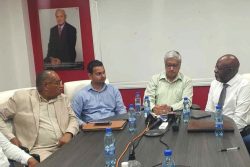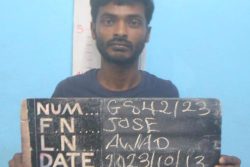Dear Editor,
Permit to raise some questions for your columnist, Professor Nigel Westmaas, on his piece “Summarising the 1856 ‘Angel Gabriel’ Guyana Riots” in SN of Sunday March 20. I have the University of Guyana’s History Today programme on radio to thank for my knowledge of the Angel Gabriel and Cent Bread riots. I think that it was Tota Mangar who did those programs. The main question I have is why we have never heard much of one fact that even now is tucked away in a corner of the article as it were. It is that African Guyanese and Indo-Guyanese rioted on the same side against the Portu-guese. “One report stated that “Creoles, sometimes accompanied by East Indians and African immigrants, broke the windows and door of shops, …” It does not appear in this version either: http://www.guyana.org/features/guyanastory/chapter58.html. I have a theory. It is that it is in the interests of some to minimize that occurrence so that the contrived animosity at elections time can be
maximized. I say this because I recall an accident just before the 2006 elections. It took place on the EBD and the person who went to the rescue of the passengers in the damaged vehicle filled with Indians was an Afro-Guyanese when according to the passengers, everyone else was passing them by. The news quickly faded from the minds of the public.
While Guyana has been a land of many road accidents (those of us old enough would recall the police resorting to putting white crosses at the site of accidents on the East Coast highway and giving up after a while because of the number of crosses they probably needed to put up) and it would have been overtaken anyway, being suspicious by nature, I think it was inconvenient to the preferred narrative at elections time. Even during the radio broadcast of History Today, I don’t recall that being mentioned. Incidentally, Professor Selwyn Ryan in his book, Sharks and Sardines, in which he analysed the underachievement of Blacks in business in Trinidad and the Caribbean, quoted a report from an Englishman saying that “trade was the destiny of blacks in British Guiana.” He had apparently made this observation from what he saw in the markets during the post-slavery period. It must have taken some orchestration to dispossess them of that lead. In her article in Stabroek News here
https://www.stabroeknews.com/2013/06/02/features/a-brief-history-of-the-portuguese-in-guyana-2/, Professor Mary Noel Menezes says, “This unprecedented success of the Portuguese in business aroused the jealousy and animosity of the Creoles to such an extent that riots resulted, one especially violent one, the 1856 ‘Angel Gabriel’ Riots during which Portuguese shops were extensively damaged ‒ shops but not lives.”
But in her book “Scenes from the history of the Portuguese in Guyana”, Professor Menezes wrote that one could not find a difference between goods on sale in one Portuguese shop and another. That business behaviour would emerge to be recognized as a cartel – a conspiracy against the market and legislated against in sophisticated countries. Wikipedia tells us, “A cartel is a group of independent market participants who collude with each other in order to improve their profits and dominate the market. Cartels are usually associations in the same sphere of business, and thus an alliance of rivals. Most jurisdictions consider it anti-competitive behaviour and have outlawed such practices.” So it appears that Mr. John Sayers Orr was not seeing ghosts. No wonder he changed sides. By the way, there is something so lifelike about that artist’s impression of John Sayers Orr. Mr. Errol Brewster’s drawing is almost a photograph. I agree with Professor Westmaas – truly amazing impression.
Sincerely,
Frederick Collins





